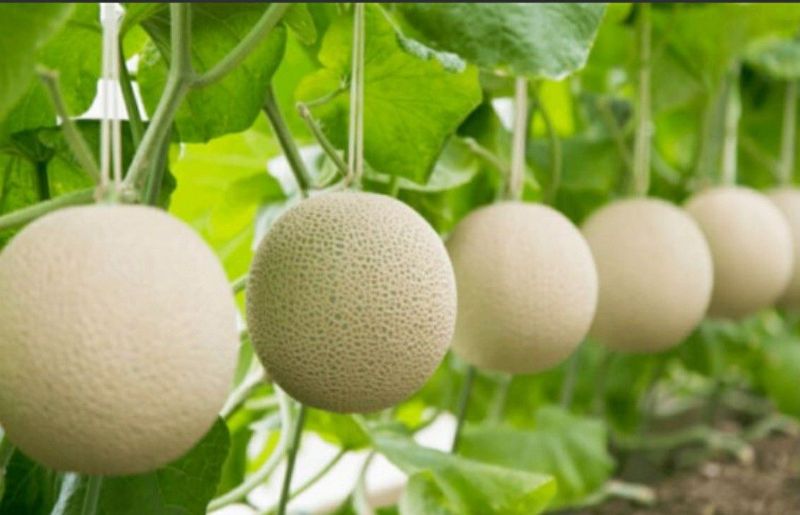The $10,000 Cantaloupe
A few times a year, we find the occasion to give gifts to our friends, families, and loved ones. In the United States, we typically do so for birthdays, anniversaries, and for many, around Christmas. While some gifts can run in the $10-20 range (for example, you can get a good trivia book for about $12), at times, a more expensive present may be in order. You may spend a few hundred dollars or even a few thousand dollars on a new electronic device, a piece of jewelry, or even a new car.
And then there are these: cantaloupes.

In the U.S., fruit is a perfectly reasonable gift — Harry & David, for example, offers a $100+ fruit basket, but of course, it contains a lot more than fruit. And bringing a nice fruit platter to someone’s dinner party is also typically welcome and appreciated. But the cantaloupes above aren’t quite in the same category. Low-end ones sell for about $50, and the best of the best? They can fetch north of $15,000.
Fruit, in general, is a luxury in Japan, and fruit is a commonly-given gift. Per the BBC, “even run-of-the-mill apples can cost $2 (£1.25) or more each in central Tokyo, and families tend to share one or two around the dinner table, chopped up.” And a high-end fruit seller had apples that were “the size of a child’s head, with evenly red, blemish-free skin on sale for 2,100 yen, or $25 (£15.80)” per apple, and a box of a dozen “perfectly matched” strawberries at the equivalent of about $80.
But the cantaloupes above are the standouts among the luxury foods. Called the Yubari King, the cantaloupes are tended to with special care. They’re a hybrid of two somewhat common cantaloupe cultivars, so genetically, they’re not all that special. But the way they are grown sets them apart. As Mashed explains, the growers “remove all but one of the flower buds on the vine to ensure that the melon won’t have to compete with other fruits for nutrients. They’re generally grown in greenhouses in soil rich with volcanic ash, are often pollinated by hand, and can be grown in individual boxes for protection. The fruits are harvested with a pair of scissors.” And the attention given each fruit is extraordinary. As Atlas Obscura notes, “precious King of cantaloupes is given royal treatment by growers who wipe the fruit clean every day while it’s still attached to its plant. The melons also get their own paper hats [seen here], to prevent sun scald from spoiling the fruit and perhaps also to help them ripen quickly.” The process, from seedling to picked fruit, runs about 100 days.
And then comes the grading. Trained melon inspectors examine each individual cantaloupe. Per Tasting Table, the fruit “with flaws are given the lowest mark, or ‘yuki,’ while the remaining top three tiers — ‘fuji,’ ‘yama,’ and “shiro’ — are decided based on levels of sweetness and perfection, with only 1 out of every 1,000 melons harvested making the highest grade, or ‘fuji’ cut.” (The inspectors can, apparently, tell how sweet the fruit will be without having to cut into the melon.) The “yuki” fruit are available for purchase at around $50 or so per melon, an order of magnitude more than what you’d pay for a typical cantaloupe in the United States. And the “fuji’ ones? Be prepared to take out a loan, unless you’re rather wealthy — in 2019, a pair of them sold for ¥5 million — the equivalent of $45,500 — at auction.
Bonus fact: If you want an expensive cantaloupe, Japan is your best bet, as discussed above. But if you want a huge one? You may want to try Alaska. The Alaska State Fair, which runs every August (yes, it’s happening right now) has an entire section set aside for growers to show off their giant fruit and vegetables. In 2014, NPR noted that the Fair attracts a great deal of huge produce: “a 138-pound cabbage, 65-pound cantaloupe, and 35-pound broccoli are just a few of the monsters that have sprung forth from Alaska’s soil in recent years.” The reason for such huge fruits and vegetables in America’s coldest state? As NPR further reported, “it’s Alaska’s summer sun that gives growers an edge, says Steve Brown, an agricultural agent at the University of Alaska Fairbanks who also serves on the fair’s board of directors. Basking in as much as 20 hours of sunshine per day, Alaskan crops get a photosynthesis bonus, allowing them to produce more plant material and grow larger.”
From the Archives: Impressive Fruit: When people use to rent pineapples.
